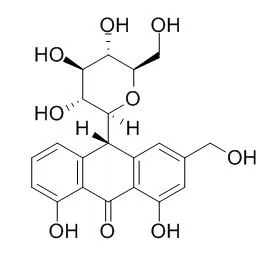| Description: |
Plants containing aloin A, aloe emodin, and structurally related anthraquinones have long been used as traditional medicines and in the formulation of retail products such as laxatives, dietary supplements, and cosmetics; however, topically applied aloe emodin increases the sensitivity of skin to UV light, although aloin A is not directly photocytotoxic, but human skin fibroblasts can metabolize aloin A to aloe emodin. Aloin A and aloe emodin have antibacterial activity against Gram-positive and Gram-negative bacteria. |
| In vitro: |
| Free Radic Biol Med. 2003 Jan 15;34(2):233-42. | | In vitro studies on the photobiological properties of aloe emodin and aloin A.[Pubmed: 12521605] | Plants containing Aloin A, aloe emodin, and structurally related anthraquinones have long been used as traditional medicines and in the formulation of retail products such as laxatives, dietary supplements, and cosmetics.
Since a recent study indicated that topically applied aloe emodin increases the sensitivity of skin to UV light, we examined the events following photoexcitation of Aloin A and aloe emodin.
METHODS AND RESULTS:
We determined that incubation of human skin fibroblasts with 20 microM aloe emodin for 18 h followed by irradiation with UV or visible light resulted in significant photocytotoxicity. This photocytotoxicity was accompanied by oxidative damage in both cellular DNA and RNA. In contrast, no photocytotoxicity was observed following incubation with up to 500 microM Aloin A and irradiation with UVA light. In an attempt to explain the different photobiological properties of Aloin A and aloe emodin, laser flash photolysis experiments were performed. We determined that the triplet state of aloe emodin was readily formed following photoexcitation. However, no transient intermediates were formed following photoexcitation of Aloin A. Therefore, generation of reactive oxygen species and oxidative damage after irradiation of Aloin A is unlikely.
CONCLUSIONS:
Although Aloin A was not directly photocytotoxic, we found that human skin fibroblasts can metabolize Aloin A to aloe emodin. | | Nat Prod Commun. 2014 Jul;9(7):949-52. | | A new antimicrobial anthrone from the leaf latex of Aloe trichosantha.[Pubmed: 25230501] |
METHODS AND RESULTS:
Phytochemical investigation of the leaf latex of Aloe trichosantha by preparative TLC gave two closely related anthrones, Aloin A/B (1) and aloin-6'-O-acetate A/B (2). The identity of the compounds was established from HRESI-MS, 1H, 13C, DEPT, HMQC and HMBC spectral and chemical data. Whilst Aloin A/B occurs in several Aloe species, aloin-6'-O-acetate A/B was isolated for the first time.
CONCLUSIONS:
The isolated compounds inhibited growth of several bacterial and fungal pathogens with minimum inhibitory concentration (MIC) from 10 to 400 microg/mL and 800 to 1000 microg/mL, respectively. |
|






 Cell. 2018 Jan 11;172(1-2):249-261.e12. doi: 10.1016/j.cell.2017.12.019.IF=36.216(2019)
Cell. 2018 Jan 11;172(1-2):249-261.e12. doi: 10.1016/j.cell.2017.12.019.IF=36.216(2019) Cell Metab. 2020 Mar 3;31(3):534-548.e5. doi: 10.1016/j.cmet.2020.01.002.IF=22.415(2019)
Cell Metab. 2020 Mar 3;31(3):534-548.e5. doi: 10.1016/j.cmet.2020.01.002.IF=22.415(2019) Mol Cell. 2017 Nov 16;68(4):673-685.e6. doi: 10.1016/j.molcel.2017.10.022.IF=14.548(2019)
Mol Cell. 2017 Nov 16;68(4):673-685.e6. doi: 10.1016/j.molcel.2017.10.022.IF=14.548(2019)